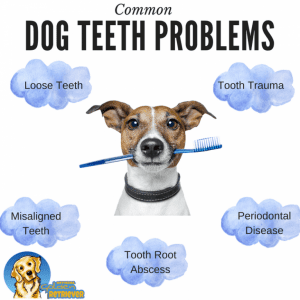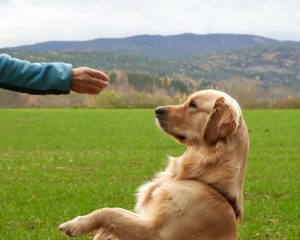Did you know that tooth decay is a huge problem for your Golden Retriever?
Dogs use their mouths for a variety of things---from eating food to showing us affection, holding things, and even playing. So, you need to know that to your dog, his teeth are one of the most important parts in his body.
And, it is your responsibility to take care of your furry friend’s teeth.
In this blog post, we’ll be going through everything you need to know about your Golden Retriever’s teeth, how you can take care of them, common issues, and more!
Let’s begin!
Get to Know Your Goldy’s Teeth: The ABCs
Save Your Shoes, Save Your Furniture!: Teething Puppies
Common Dog Teeth Issues: A Quick Look at Diseases
Final Words: Your Dog’s Teeth Matter
Contents
Get to Know Your Goldy’s Teeth: The ABCs
Did you know that dogs, too, have two sets of teeth throughout their lives?
When your puppy is six weeks in age, he has 28 teeth in his mouth!
However, do keep in mind that this number doesn’t include the molars or premolars because puppy doesn’t need to do the grinding in the first few weeks of his life because he sustains mainly on his mother’s milk or other soft food.
What happens to these baby teeth?
Puppies start to shed the baby teeth when they reach the age of 4 months and some don’t even shed at are and may still be present in your dog’s mouth.
A full-grown dog has 42 teeth.
However, keep in mind that this number depends on the breed.
Save Your Shoes, Save Your Furniture!: Teething Puppies
If you’ve has a puppy before, you know that teething is probably the worst time for your furniture, shoes, socks, etc.!
Let’s take a look at how your puppy starts getting those pearly whites, shall we?
Following is the order in which teaching takes place in puppies:
- Incisors are the first to break
- Canines are next in line
- Premolars come next
- Finally, the molars come in
Teething is a frustrating time for your Goldy.
You should get some good chew toys for your puppy to keep him busy---and off your furniture and legs!
Teething puppies can be a menace but, there are a few things you can do to save your precious belongings:
- Train your dog well
- Reroute your dog’s energy onto things he’s allowed to chew/ put into his mouth
In my experience, I’ve found that re-routing works the best.
Common Dog Teeth Issues: A Quick Look at Diseases
Did you know that about 85 percent of dogs over 4 years of age are plagued with gum disease?
Dogs don’t let you know that they have problems with their teeth so, it can be hard to diagnose a problem until it has become serious.
This is because for wild dogs, showing any signs of pain and discomfort would make a them vulnerable to getting attacked---your Golden Retriever shares the same instincts.
There are a few signs that you should look out for, such as:
- Change in eating habits
- Loss of appetite
- Rubbing face against things
- Swelling on the face
Loose Teeth
Loose teeth are a problem for adult dogs as they are a result of trauma to his mouth. A loose tooth may also indicate gum loss or advanced periodontal disease among other illnesses.
I would highly recommend you to visit your vet at the first sign of a loose tooth.
Misaligned Teeth
Misaligned teeth can occur due to extra deciduous teeth or due to the misalignment of the upper or lower jaw.
Misaligned teeth are taken care of only if they:
- Cause pain
- Prevent the dog from eating food or drinking
Periodontal Disease
Periodontal diseases begin when the plaque present in your dog’s teeth turns into tartar which then under the gum line and causes gingivitis. This disease causes the gums to lose their function and recede, which causes tooth loss.
A few factors that increase the risk:
- Age
- Immune system
- Diet
- Chewing habits
- Dental hygiene
You should start this at a very early age so that your little puppy gets used to mouth handing and brushing, etc.
Tooth Trauma
Slab fractures are commonly seen in dogs that forcibly bites a hard things. This causes a section of your dog’s tooth to flake off which can cause a chip or a large gaping fracture.
These teeth expose the nerves become which causes pain and in some cases, the nerve dies and the pain ultimately subsides.
Tooth Root Abscess
This occurs when the root of the dog’s tooth becomes exposed to the harmful bacteria and may even be caused because of gum damage which may result from periodontal disease.
The abscess can spread to the surrounding teeth making it difficult to determine which tooth is infected.
Final Words: Your Dog’s Teeth Matter
As with all parts of your dog’s body, taking care of the teeth is important.
We don’t truly understand how important your dog’s teeth are to him but, if you think about it, you’ll find out just how much your dog uses his mouth throughout the day.
Dogs don’t really show signs of tooth trouble until it’s too late.
So, you need to take your furry friend to the dentist to make sure everything’s okay from time to time. Taking good care of your dog’s teeth will ensure that he gets to live a happy and pain-free life.
If you know someone who can benefit from this article, please share it! And, let me know your thoughts in the comments section.








Leave a Reply
You must be logged in to post a comment.